Depicting the Indian: A Painter’s Photographs and Visual Documentation in the 1890 Census
By: Jacquelyn Davila '22
Access the digitized collection of Julian Scott's Photographs for the 11th Census via Princeton University Library.
Over the old hunting ground, across the silvery streams which thread the brown barrens and plains, up the tall mountains among the towering pines to the snow-capped and sun touched summits, in the land once the home of his people, the Indian of to-day can cast only a longing eye, and reflect. The plains are silent to the tread of the old Indian host; no monuments or structures tell their story; no footprints in the rocks, no piles of carved or sculptured stone speak of their patience, ingenuity, or their presence … For the remaining Indian, the painter, the museum, and the art preservative alone can tell the story ...[1]
In 1890, Vermont-native, Julian A. Scott embarked on an artist’s journey. This was no European tour; Scott was not headed for the galleries of Venice or Paris. He was going West.
A painter educated at the National Academy of Design and a pupil of Emanuel Leutze, Scott had long made a name for himself in and out of the art world.[2] Born the son of a small-town jeweler, Scott had left his hometown of Johnson, Vermont at age fifteen to join the Union army as a drummer boy.[3] If Scott went into the war as a boy, he certainly came out of it as a hero. Scott had been awarded the Congressional Medal of Honor in 1862 after braving a storm of bullets and wading across a creek to rescue a wounded soldier.[4] After the war, Scott became a painter and went on to receive praise for his realistic renderings of battlefield scenes.[5]
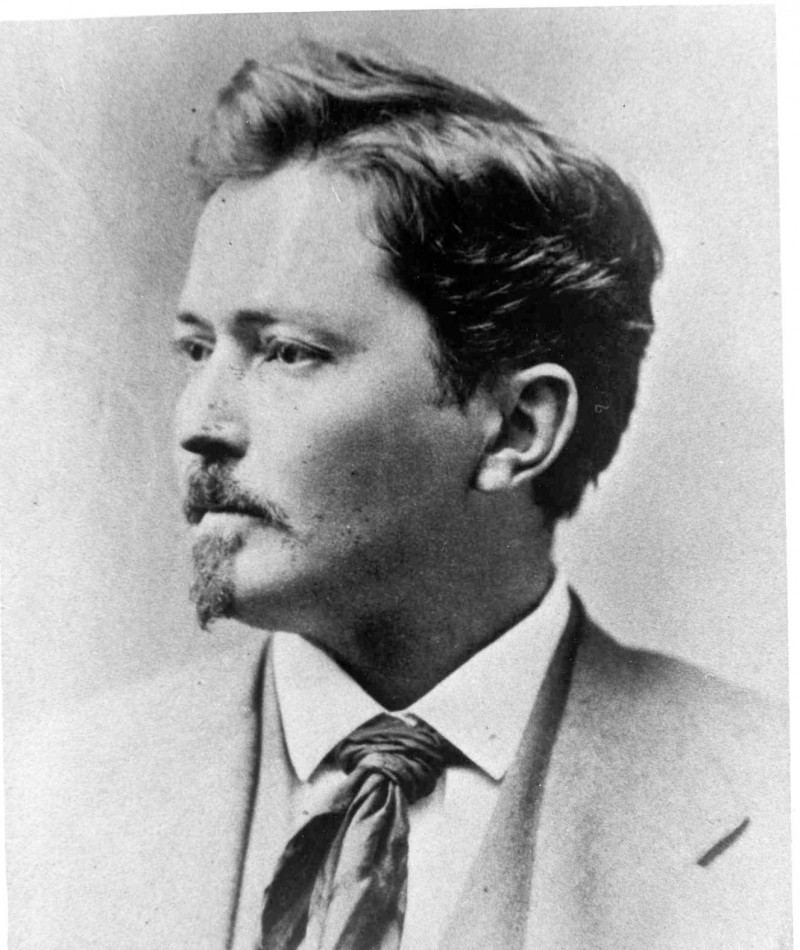
In 1890, the painter had a new project. Along with a retinue of professional surveyors, cartographers, photographers, and artists, Scott had been hired as a “special” agent of the U.S. government. These agents set out across the continental American empire, tasked with producing visual data (maps, charts, drawings, paintings, photographs, even music scores) that would be included in the upcoming 11th Census.[6]
So Scott had landed on a new subject: the American West. Julian Scott was being paid to paint the story of the Indian. He was to paint their past and their present and perhaps even their future. It was Scott’s job, after all, to use his artist’s eye to curate the story of the Indian: to portray the native peoples and landscape of the place that was becoming the American West, and to show how they would (or would not) fit into the vision the United States was imagining for itself.
On August 25, 1890, during his stay at the Kiowa, Comanche & Wichita Agency in Oklahoma, Julian Scott began writing a letter that he would never finish. It was a hurried yet animated message, embellished with figurative language and wreathed in an assortment of grammatical slip-ups. In the letter, which was meant for a Mr. Baldwin, Scott apologized for the “suddenness of [his] departure” and shared news of his activities in Indian Territory. Scott was feeling good about himself. Not only had he managed to avoid falling ill on the road, but “all [his] time [was] most profitably spent in observing [the] country, its resources, the Indians, and their condition.” Moreover, he had just purchased a Kodak no. 2 camera, which he would use to capture dozens of images on his travels through Arizona, New Mexico, and Indian Territory.[7]
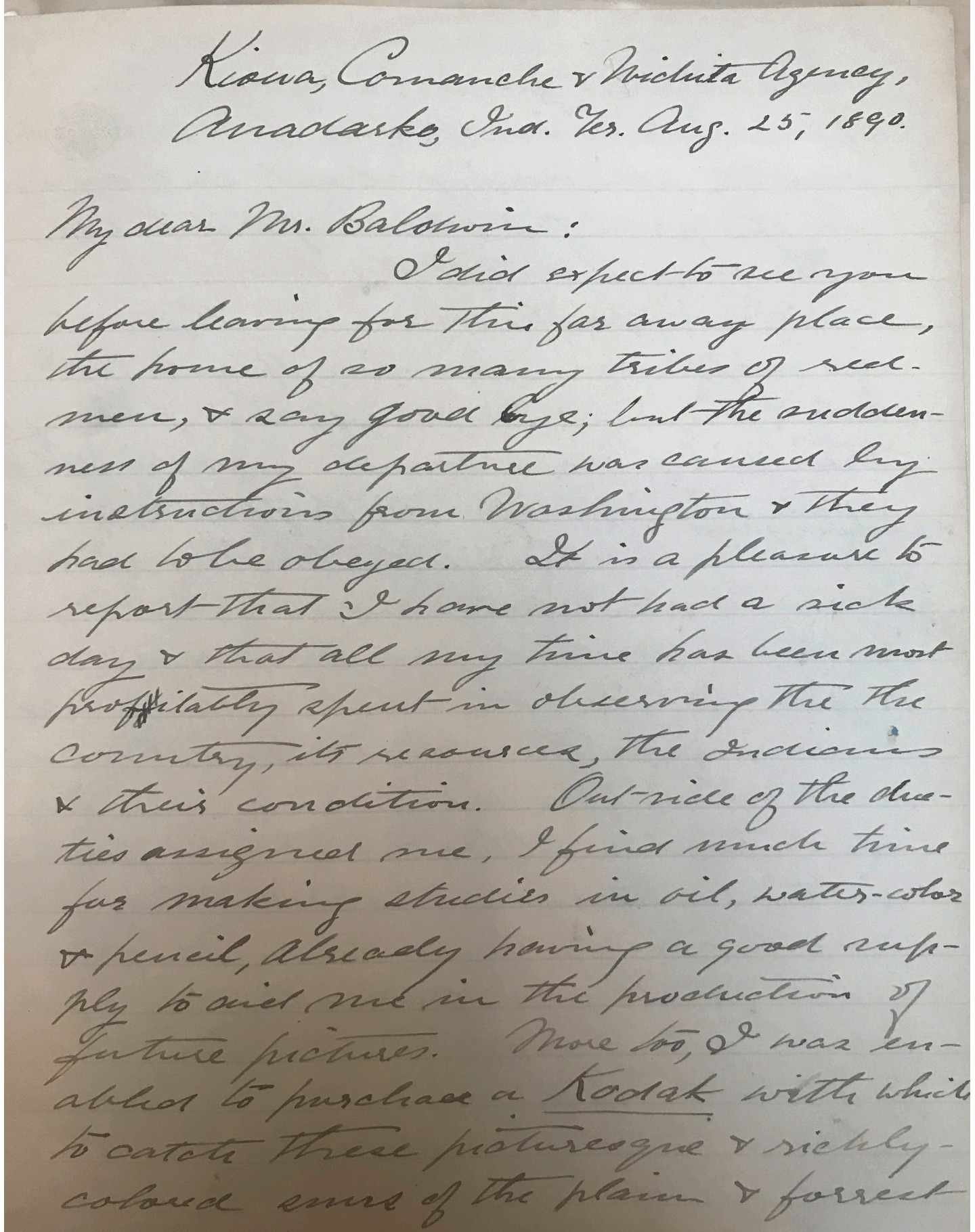
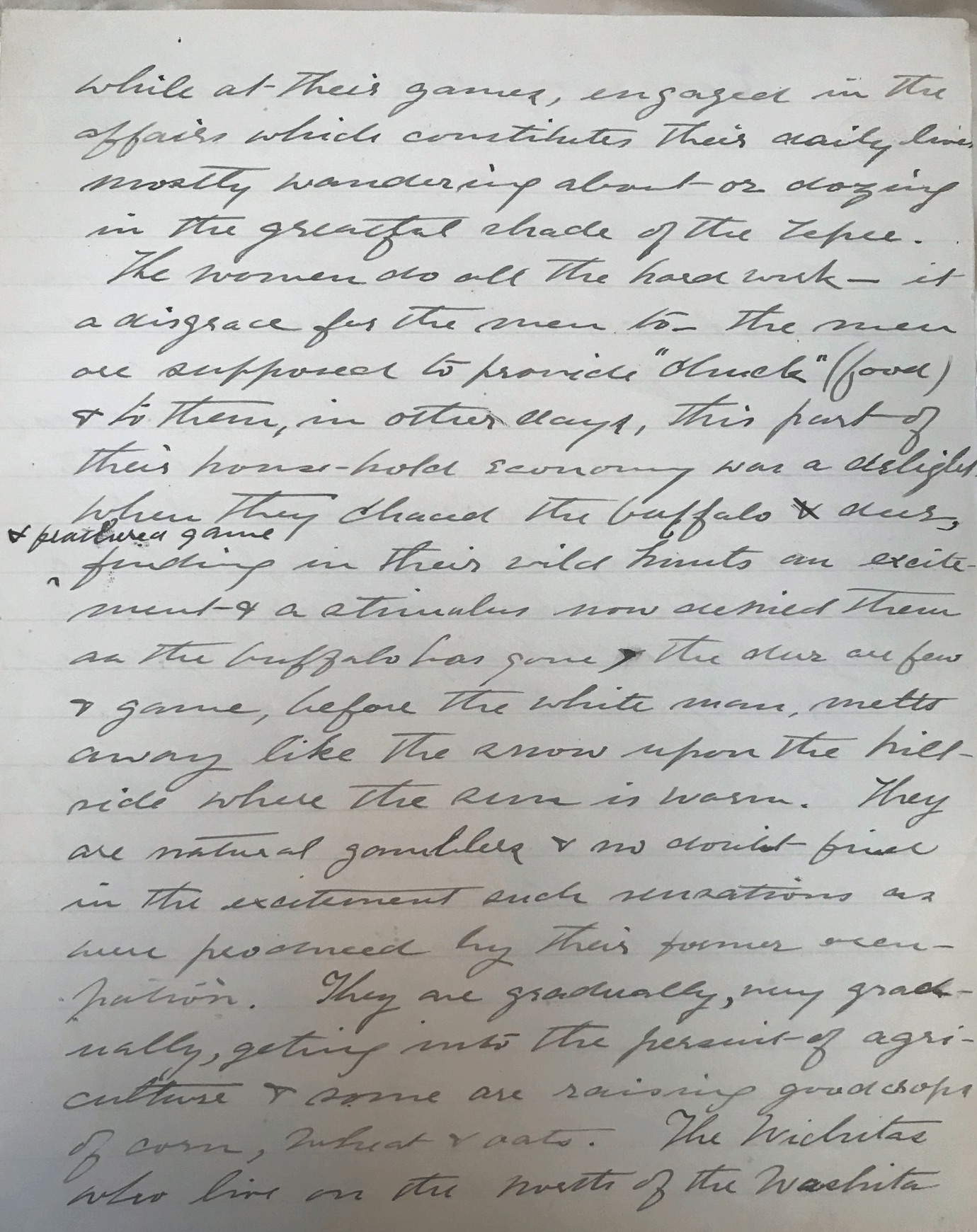
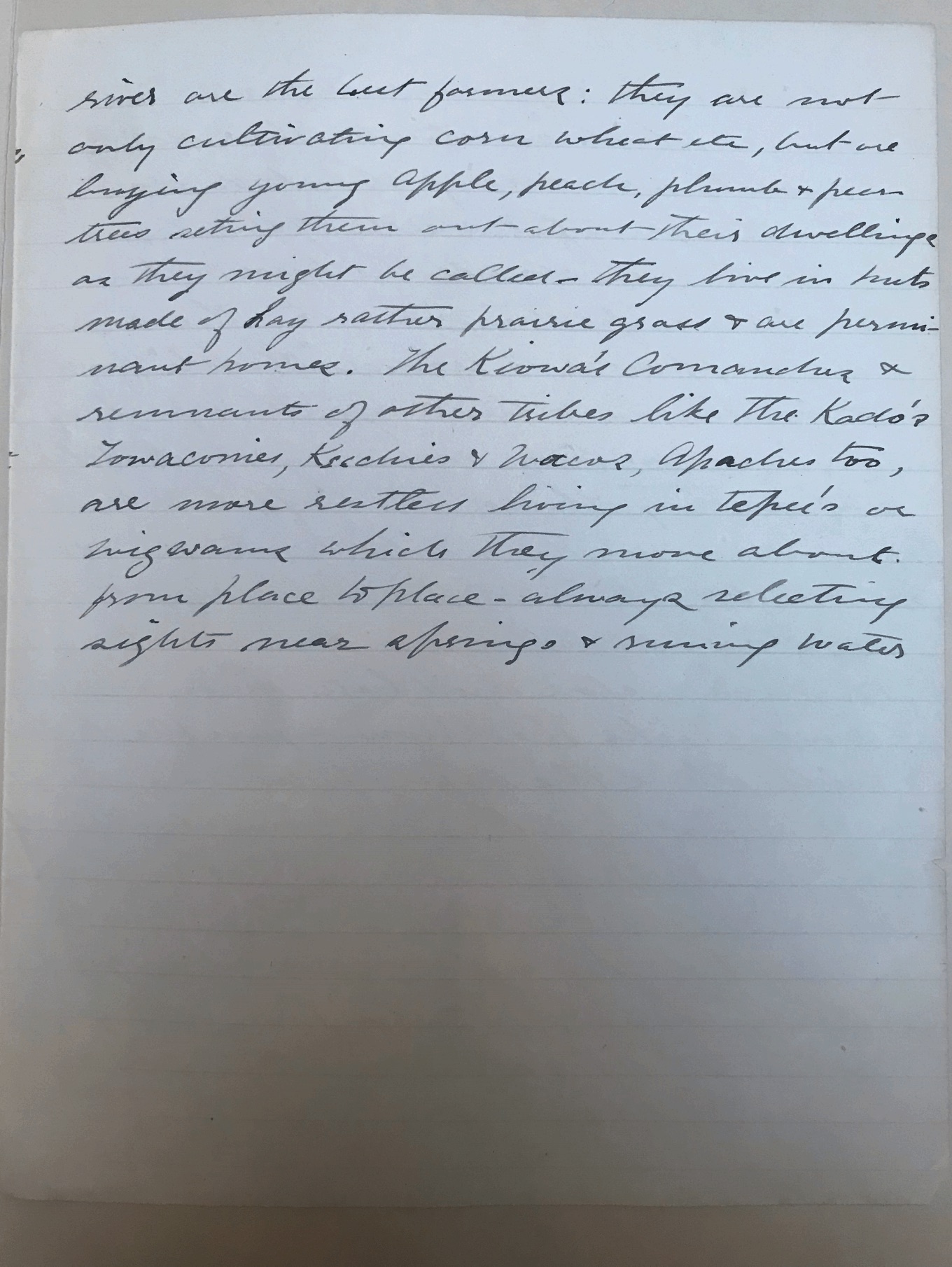
This unfinished letter is found in Box 2, Folder 1 of the Julian Scott in 1890 for the 11th United States Census collection. A transcription is provided below:
Kiowa, Comanche & Wichita Agency,
Anadarko, Ind. Ter. Aug. 25, 1890.
My dear Mr. Baldwin,
I did expect to see you before leaving for this faraway place, the home of so many tribes of red men, & say good bye; but the suddenness of my departure was caused by instructions from Washington and they had to be obeyed. It is a pleasure to report that I have not had a sick day and that all my time has been most profitably spent in observing the the country, its resources, the Indians, and their condition. Outside of the duties assigned me, I find much time for making studies in oil, water-color, and pencil, already having a good supply to aid me in the production of future pictures. More too, I was enabled to purchase a Kodak with which to catch these picturesque and richly colored [illeg.] of the plain and forest while at their games, engaged in the affairs which constitute their daily lives, mostly wandering about or dozing in the grateful shade of the tepee. The women do all the work – it a disgrace for the men for the men are supposed to provide “chuck” (food) and to them, in other [illeg.], this part of their household economy was a delight. When they chased the buffalo and deer, and feathered game, finding in their wild hunts an excitement and a stimulus now denied them as the buffalo far gone, the deer are few and game, before the white man melts, away like the snow upon the hillside where the sun is warm. They are natural gamblers and no doubt find in their excitement such sensations as were produced by their former [illeg.]. They are gradually, very gradually, getting into the persuit [pursuit] of agriculture and some are raising good crops of corn, wheat, and oats. The Wichitas who live on the north of the Wishita river are the best farmers: they are not only cultivating corn wheat [illeg.], but are buying young apple, peach, plumb and pear trees setting them out about their dwellings as they might be called. they live in huts made of hay rather prairie grass and are permanent homes. The Kiowah Comanches and remnants of other tribes like the Kado’s Iowacomes, Kechies, and Wacos, Apaches too, are more restless living in the teepees or wigwams, which they move about from place to place, always selecting sights near springs and running water [end]
Scott’s original photographs and his unfinished letter survive in Princeton’s collection, Julian Scott Photographs for the 11th Census, 1890-1891, which comprises two boxes held by Special Collections in Firestone Library. One-hundred seventy of Scott’s photographs are stored in the first box. His unfinished letter is stored in a second box along with a collection of research materials compiled and provided by the seller. These research materials include a copy of an extra census bulletin entitled “Moqui Pueblo Indians of Arizona and Pueblo Indians of New Mexico,” which was published in 1893 and includes some of Scott’s photographs of the Snake Dance and Laguna Pueblo. The second box also contains a chronology of Scott’s life, descriptions of each photograph, and digitized copies of the entire collection.[8] This paper explores Scott’s journey as a creator and curator of visual data for the 11th census through an analysis of his photographs, the unfinished letter, and a separate census volume published in 1891 entitled Report on Indians Taxed and Not Taxed in the United States (except Alaska) (ITNT).
Scott’s contributions to the 11th Census—his photographs as well as the paintings and drawings informed by his census work—showcase the central role artists (and other makers of visual data) have had in shaping our memory of the American West. As an artist for the 1890 census, Scott was not just producing art; he was using his training and the newly accessible medium of photography to organize visual data about Indians in a way that was legible and useful to the American state. By examining his depictions of the West, we can learn more about the ways in which the documentation of visual data was just as central to the cultural and physical subjugation of indigenous people as written documentation.
In 1890, at the advent of the twentieth century and the start of Scott’s journey, the nation seemed to be consumed by its own contradictions. Americans eagerly awaited the results of the 11th census, hoping it would confirm the extent of their progress as a nation. The country was fast industrializing, millions of acres had been settled, and thousands of miles of rail tracks had been set. Americans expected their population to be growing exponentially too. But this self-assurance was not absolute. When the 11th census—which was calculated using a groundbreaking new technology in mass data processing, the electrical tabulating machine—revealed that Americans were not as numerous or dominant as they thought, the anxieties of the developing nation were further exposed. In 1890, Americans were wary of the newly-arrived immigrants from southern and eastern Europe. Some even looked at the urbanizing country with regret, yearning for the era of the independent farmer when man was more connected to the soil.[9]
And even though the general agreement seemed to be that the Indians were a vanishing race, a “people of the past and much diminished in numbers,” the government continued to demonstrate a vested interest in documenting the Indian, not just for history, but in order to better “manage” him in the present and mold him for the future. The indigenous population of the West was indeed decreasing, decimated by decades of displacement, disease, and drought. Far from being obsolete remnants of the past, however, indigenous peoples continued to be both a source of fascination and anxiety for Americans. The “Indian problem” persisted. The 1890 census—the first census to include Native Americans with the rest of the U.S. population—presented an opportunity to collect data about Indian populations to better understand how to control them.[10]
Why, then, would the data-loving bureaucrats of the “electrical census” hire a painter to document the Indian? Painting was an old method of documenting visual information. Photography seemed better suited for the unbiased and factual images we would expect from a census. But in 1890, photography was not perceived as inherently superior to other forms of visual information. The American West and photography had “come of age together,” but just as the West continued to be a contested landscape, the “visual marketplace” of the nineteenth century was in flux, and photographers often struggled to compete with other visual and literary media.[11]
Unsurprisingly, Scott had not been the sole artist hired as a special agent for the census. The work of other professional painters like Gilbert Gaul and Henry Rankin Poore and numerous professional photographers like Ben Wittick is featured prominently throughout Indians Taxed and Not Taxed.[12] It simply made sense in an era of unprecedented data collection for the American state to document the Indian, not solely through photography or painting, but through a wide range of visual media.
As a professional painter and amateur photographer at the turn of the twentieth century, Julian Scott was an artist at a temporal crossroads. By the 1890s, the Kodak camera made photography more widely accessible, making “photography a truly ubiquitous part of American culture.”[13] Some began to claim that photography was a more “accurate,” “unbiased,” even scientific method of capturing visual information, appealing to those who wanted to gain a sense of veracity or truth from images. It is not hard to imagine that by 1890, some painters may have started to worry that photography's growing accessibility could displace them from the visual marketplace. Others like Julian Scott, however, saw the value of photography as an aid to their art. Scott’s desire to use his Kodak to “catch [the] richly colored” lives of the Indians, as expressed in his unfinished letter, may sound odd to the modern reader. Scott was not referring to chromatic color (though as a painter he was able to transform the black and white into colors) but to the important details, the snippets of visual data, that characterized the life of indigenous people at the time.
While none of Julian Scott’s Kodak snapshots appear in the Report On Indians Taxed and Indians Not Taxed, he did contribute a total of 33 visuals to the volume, including drawings, paintings, and one map.[14] Some of the drawings and paintings that are printed in the volume were likely derived from Scott’s photographs. Photographs #13-#17 and #50, taken at a “beef issue” in Anadarko, Indian Territory in 1890, capture Indian men in motion as they move through the landscape on horseback in order to secure their mobile government-sponsored rations: cows.[15] A painter might struggle to reproduce this moving scene in an unfamiliar landscape all while trying to note its colors, but Scott understood that his Kodak snapshots could enhance the quality of his paintings. In this particular case, Scott captured several photos that would later inform his painting, Issue Day, which was signed and captioned “Issue Day at Anadarko, I.T. 1890,” the same year the photographs were taken.[16] Similarly, for his portrait, Quanah Parker, chief of the Quah-hah-das Comanches - Oklahoma, 1890, Scott seems to have used photograph #63, a photograph of Quanah Parker, as a visual reference.[17]
The above photographs #15, 16, 17, & 50 (from left to right) were taken in 1890 in Anadarko, Indian Territory, and may have inspired the painting reproduced as a print in ITNT.
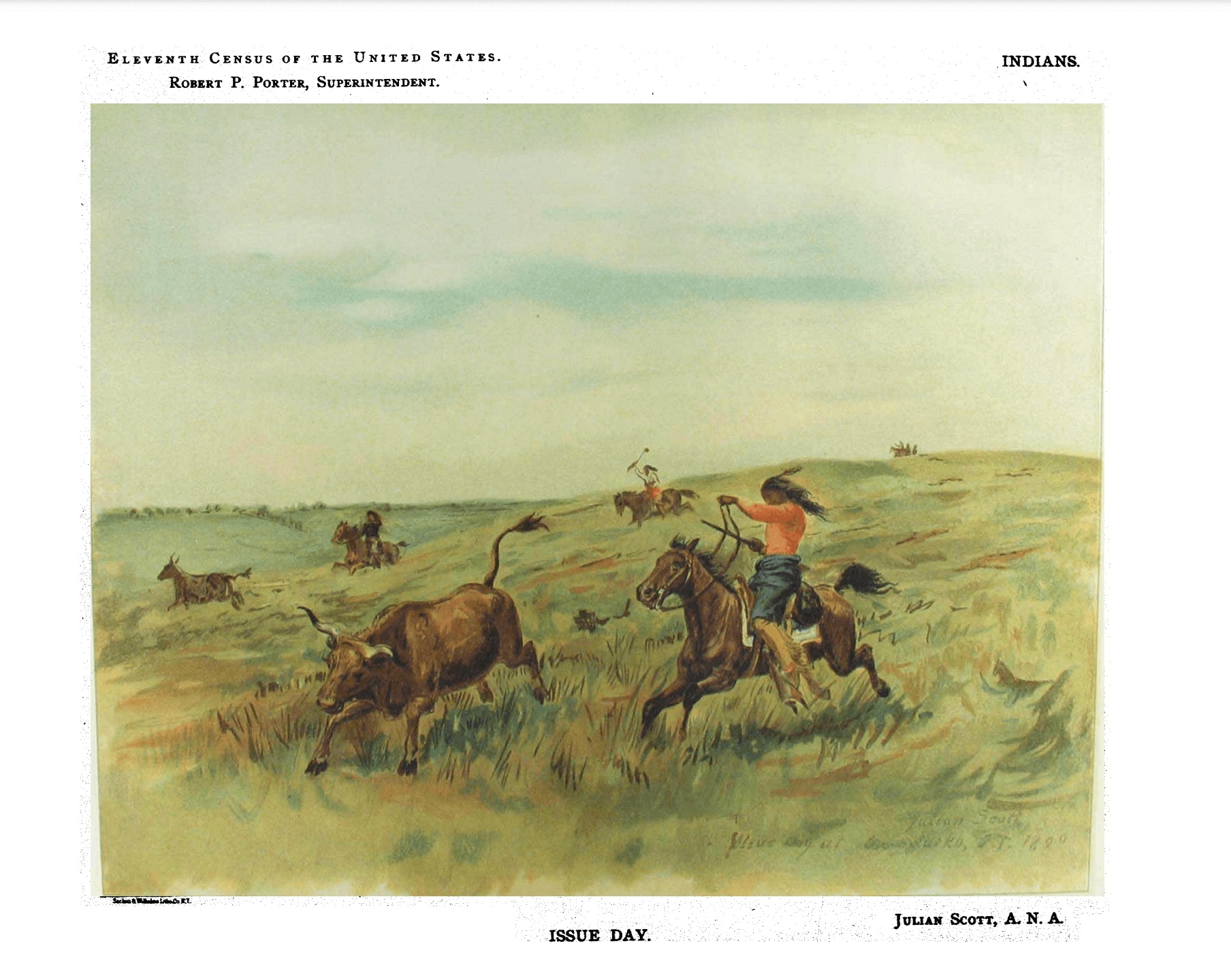

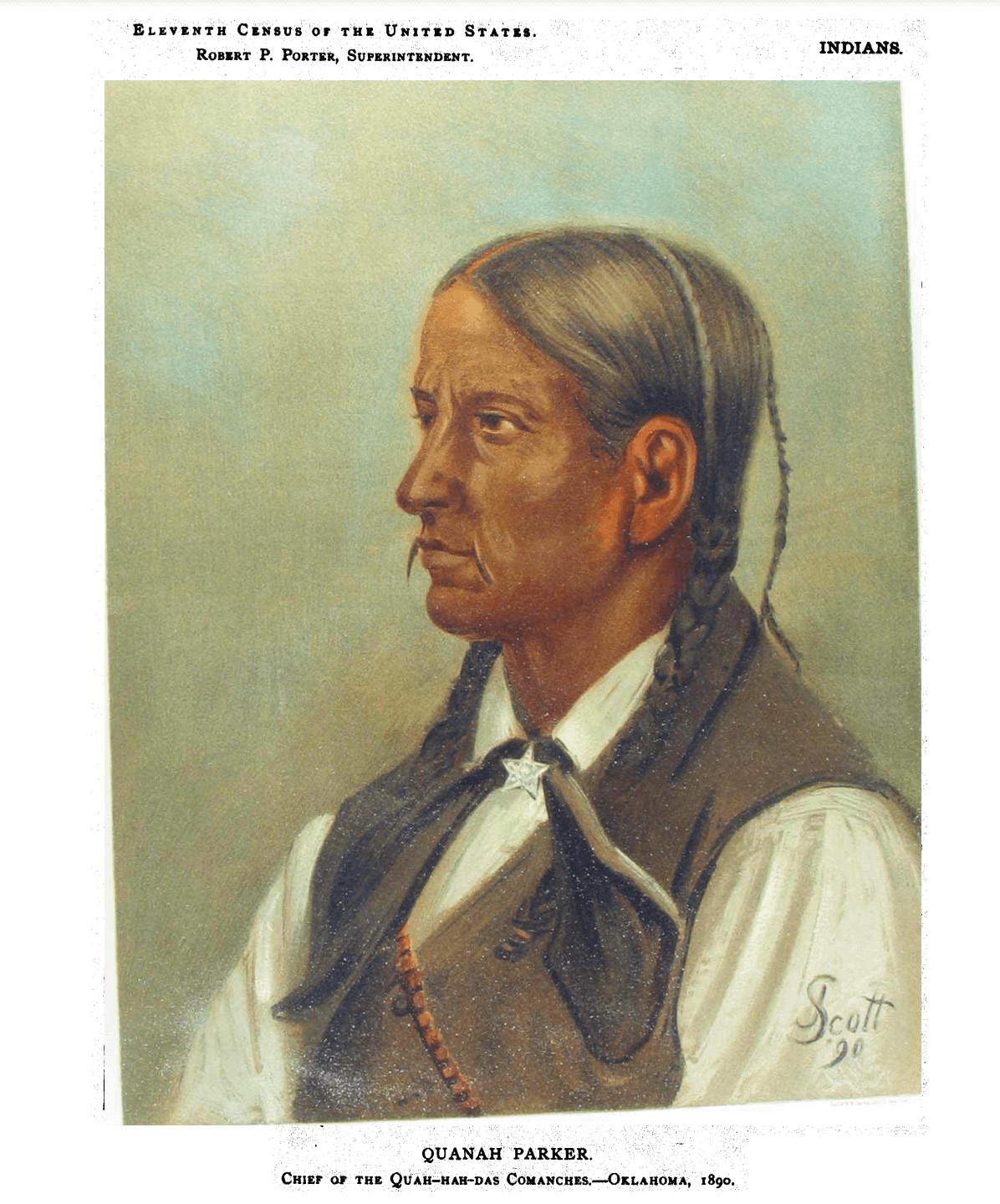
Another striking example of Scott’s use of photography as a visual aid to his art is his Kodak snapshot #154, captioned “Shi-paul-a-vi, Middle Mesa,” which was taken in early November 1890 and directly matches up with his drawing Shipaulavi, second mesa, Arizona 1890.[18] Here, Scott seems to have used his camera not to capture the motion of a scene but the magnificent stillness of the intricately rocky landscape.


Some of Scott’s photographs do not seem to transfer directly into his paintings or drawings, but hint at his process of collecting visual information related to the customs and practices of indigenous people . Such is the case of photograph #160, captioned “Ki-va at Shi-paul-i-vi” and also taken in early November of 1890. This photograph shows Hopis gathered at a kiva, with the outline of a western-style hat, seemingly produced by the photographers’ shadow, peeking at the bottom left curve of the snapshot.[19] Scott’s shadow is both figuratively and physically trespassing at this holy site, as Scott does not seem to have ended his “explorations” of the Hopi religion there. His intrusion seems to have culminated in the drawing Moqui Idols, which corresponds to the year 1890, and depicts a series of ceremonial Hopi objects, including several cachinas (or kachinas).[20]


On the other hand, the lack of skill and technique exhibited in some photographs betrays Scott’s still-developing familiarity with the medium of photography. Scott was a professional painter but an amateur photographer. Several of his snapshots, such as photograph #115, taken “On the trail to Ft. Defiance, Arizona” in October of 1890, are overexposed.[21] Perhaps this is more of a byproduct of working in open landscapes abounding in sunlight. The environmental conditions of the West certainly affected Julian’s painting techniques. In his unfinished letter to Mr. Baldwin at the beginning of his journey, Scott had mentioned his experimentation with different painting methods.[22] But by the end, Scott had forgone oils, “hampered by the difficulty of painting in sunlight or clear diffused daylight, a difficulty less important in watercolors.”[23] Many “roving artists [also] favored watercolors because the equipment was lightweight, highly portable, and inexpensive, and it allowed them to execute rapidly pictures of permanent quality.”[24]

Despite his amateur status in photography, one would be remiss to dismiss the value of Scott’s Kodak snapshots solely based on his lack of skill when compared to prolific photographers like Ben Wittick (whose photographs are actually included in Indians Taxed and Indians Not Taxed). Scott’s photographs are fascinating precisely because they were not taken by a professional photographer. Some of these snapshots are almost candid by modern standards, with their subjects evoking a sense of surprise. Photograph #72, for example, is a close-up of an unidentified Anglo-American woman in Santa Fe, New Mexico in October of 1890. The photo itself is already blurry, but the woman is also not looking directly at the camera or posing. Her lips are lightly pursed, and the image appears to be slightly tilted. Moreover, the next photo, #73, shows what appears to be the same woman boarding a carriage. This unposed photo illustrates the significance of Scott’s instrument, the Kodak no. 2, which allowed for the capture of quick, spontaneous shots of a body in movement. Previous plate-based technologies had required a subject to “sit” for a photograph or involved equipment so cumbersome that if the subject was not willing, he or she was at least aware of being photographed. However, the Kodak camera, which came “preloaded with a roll of flexible film [that] had a faster exposure time [and] eliminated the need to reload negatives between shots,” enabled the photographer to capture the kind of candid moments that are characteristic of snapshot photography.[25]

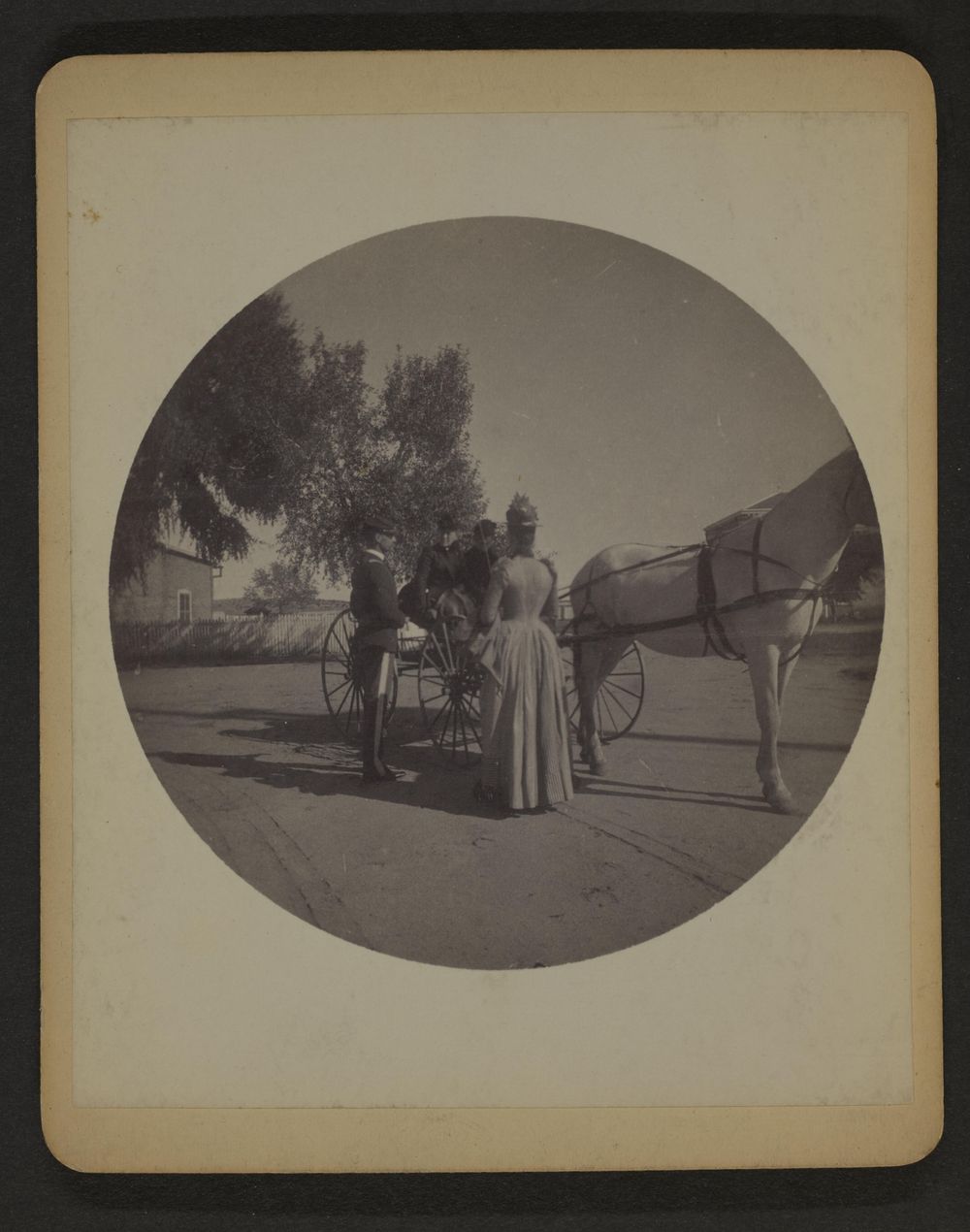
The photographs above show a woman wearing a feathered hat and dark clothing. The same woman is possibly the subject of both photographs.
Mapping the Moqui Landscape
Julian’s amateur photography and professional training in art clearly fed into his skills as a mapmaker. While the Report on Indians Taxed and Not Taxed contains an abundance of cartographic material organizing indigenous people according to linguistic, cultural, and other boundaries, Scott seems to have contributed only one map to the 11th Census: Moqui country of Arizona.[26] The map was completed in 1891, the same year that Scott returned to Hopi land and photographed the snake dance.[27] The map, which is drawn to scale and oriented using cardinal directions that are legible to Anglo-Americans, identifies the location of seven Hopi pueblos and marks their trails. Indigenous cosmologies of the Southwest were usually based on four solstitial directions plus the “above” and the “below.” But Scott’s map, like his other visual productions, was not produced to represent indigeneity as indigenous people would present it, but as it would be most legible to the Anglo-American.[28] The seven sites of the Hopi pueblos had all been photographed by Scott during his travels in 1890 and 1891. Some of these, like the aforementioned Shipaulavi, second mesa, Arizona 1890, had also been made into illustrations.[29] Before the widespread use of aerial photography in mapmaking, creators of visual data like Scott were already using landscape photography to help gather valuable geographic information and facilitate the integration of “faraway” lands into American territories.
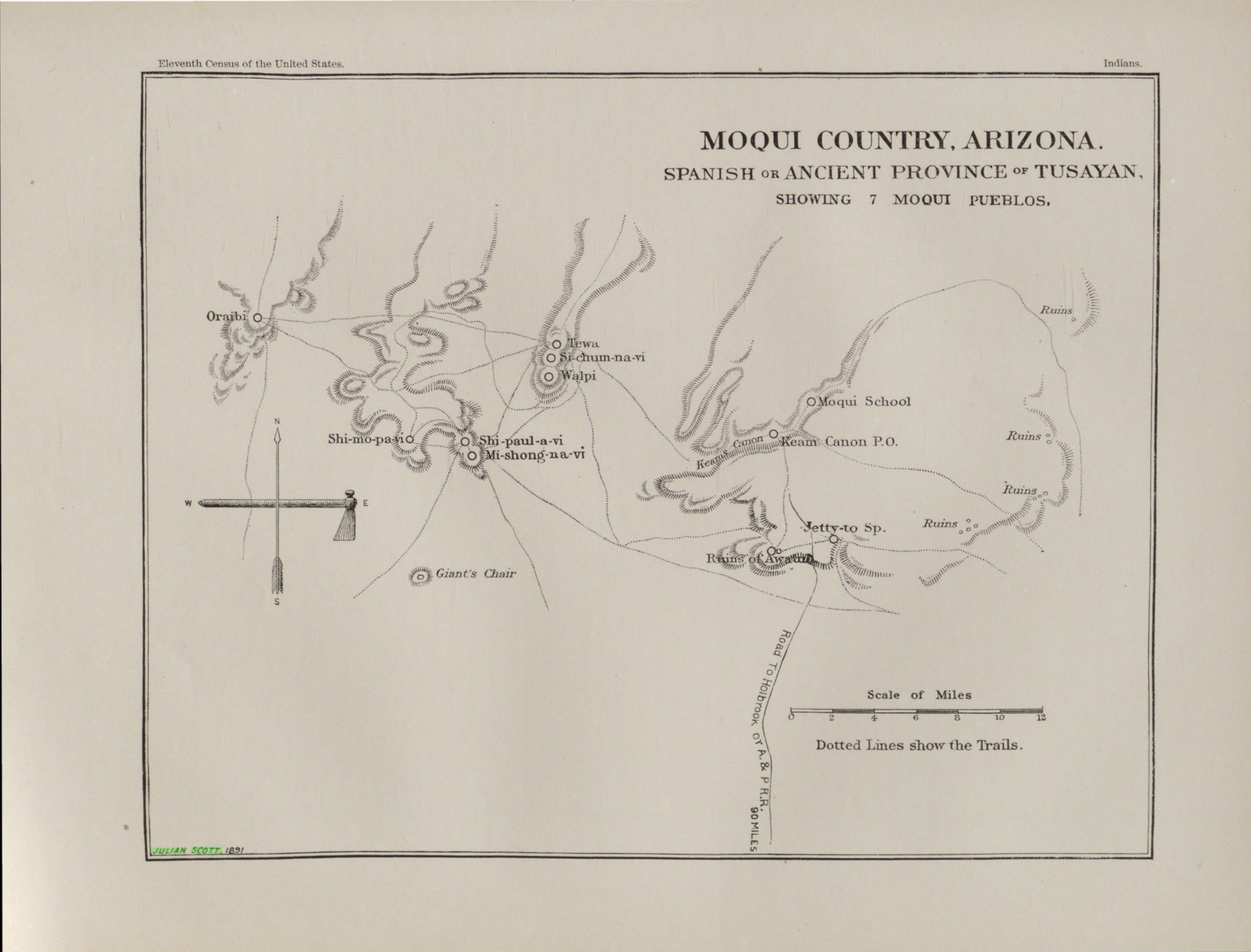
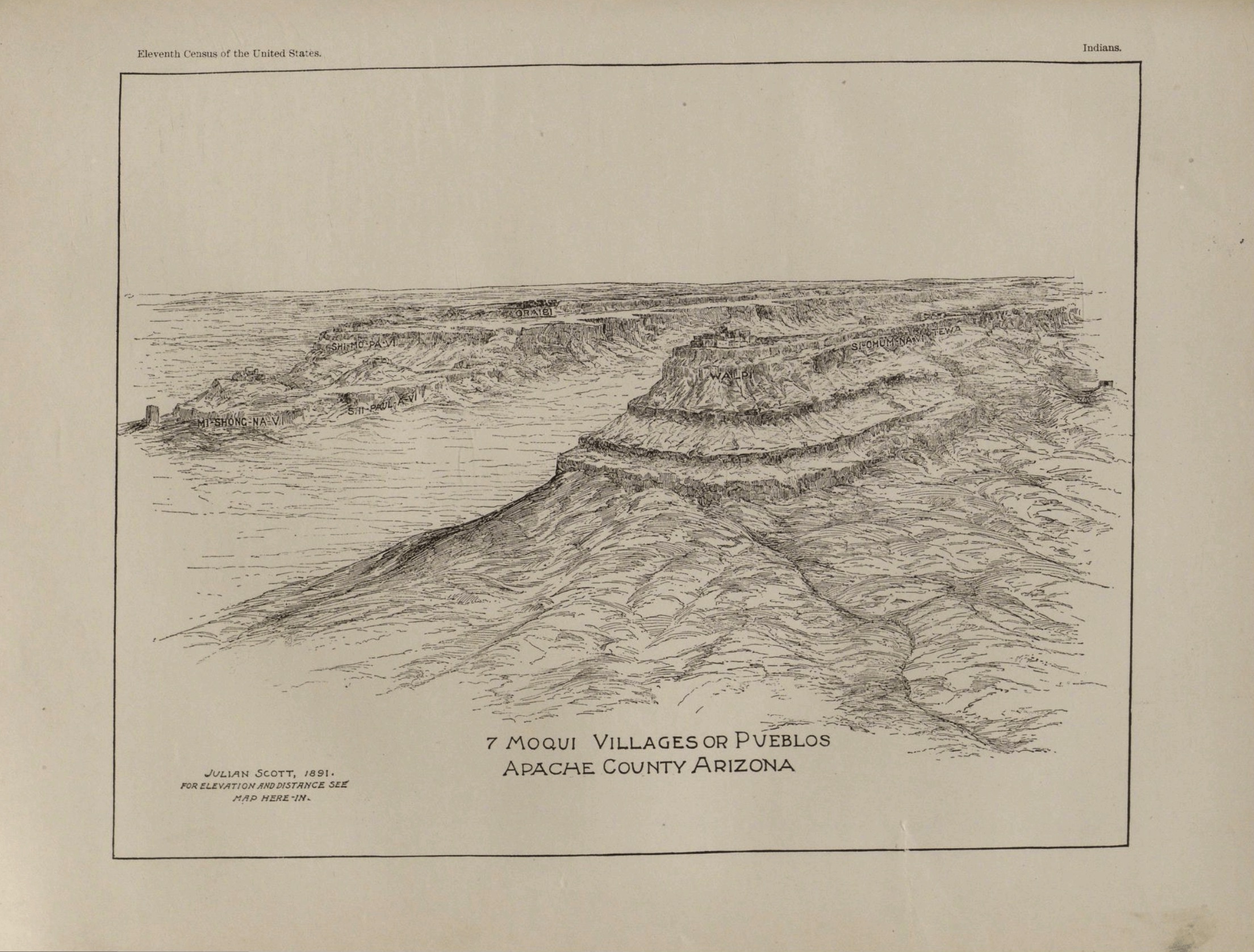
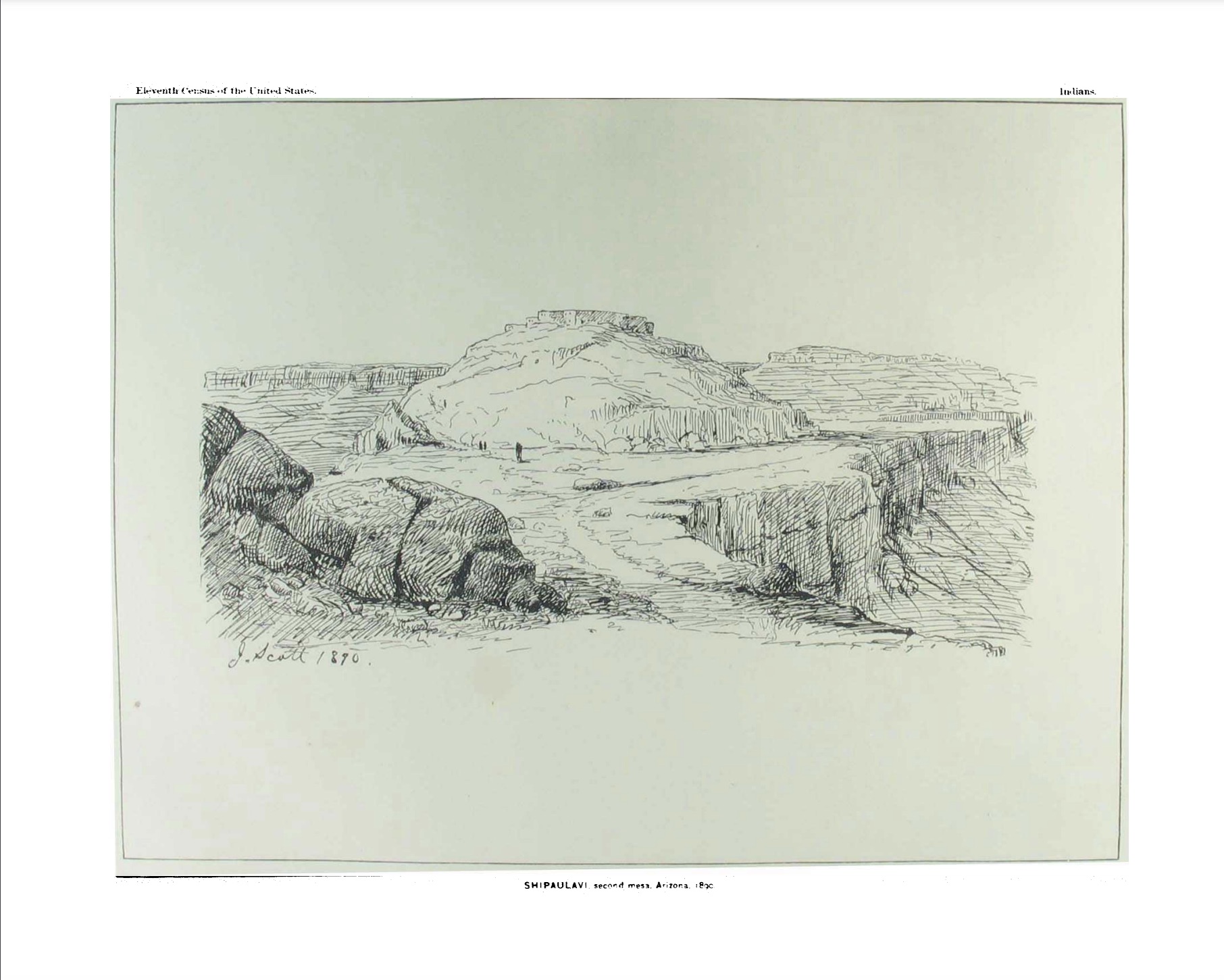
Taking this into account, the Kodak photographs depicting springs around the pueblos did not just illustrate “picturesque and richly colored” scenes; they documented the relationship between Native peoples and their environment. Scott noted in his written account included in ITNT that the Indians considered water precious.[30] According to Scott, the Moqui Snake Dance, which attracted many white tourists, was harmless: It was “simply a curious survival, with no pernicious results, and to the Indians it [was] a religious duty… an invocation to the snake deity, a water god, ‘Ba-ho-la-con-gua’ by name...”[31] Scott was able to relate the indigenous cosmology and connection to the landscape not only through his writing but through his lens.
The above photographs #152, 161, 162, and 163 (from left to right) depict the location of various water sources in and near Hopi pueblos. Photograph #164 (far right) captures a Hopi corn field, documenting some of the tribe's economic activities.
Behind the lens and canvas, Scott’s personal biases shaped what he chose to picture and what he chose to cut out of the frame. But as a “special agent,” Scott was ultimately creating visual data for the U.S. government. As a Civil War hero traveling West on Washington’s orders and funds, Scott seemed to feel a sense of belonging to the nation—or was at least aware of the benefits of proclaiming such allegiance.[32] There were direct economic benefits for the artist willing to ally himself with the state: commissions and assignments. However, there was also a sense of superiority, a sort of cultural capital, that Scott carried with him on his journey West. In that unfinished letter to Mr. Baldwin, Scott expressed a general dislike for the vices of the Indian man. Notably, Scott took two subsequent photos of a group of Indian men gambling at Keams Canyon in 1890. Were the Anglo-American settlers and government agents out West simply paragons of virtue, unmatched in their work ethic? Although Scott photographed several white subjects, there are no photos of Anglo-Americans engaging in leisure activities. Scott did not turn his Kodak on himself à la selfie-style either. Neither did he mention that for years, he had been struggling with a vice of his own: alcoholism.[33] Scott instead claimed to spend “all” his time “profitably” engaged in documenting the West for the expanding American empire.[34]
Photography, like history, is not neutral.[35] Photographs highlight the perspectives of some people—those with the resources to take photos or the power to commission them or the influence to shape the photographic marketplace—but exclude or obscure the perspectives of some communities from our visual record and collective memory.[36] History is not only documented and told through written text. Scott’s contemporaries were aware of this. Even as the authors of the 11th Census claimed that the Indian could no longer tell his own story, they understood that Native Americans had long made use of visual histories. A report in ITNT of the Arikara Indians of North Dakota read: “By painting and drawing, as well as by tradition, their personal and tribal histories have been transmitted from generation to generation.”[37] Thus, while Native Americans could depict and tell their history, their mediums were either illegible or devalued by the American state. The Indian’s agency, his ability to depict, document, and tell his own history was dismissed.
Scott's photographs, along with all the other visual materials he contributed to ITNT, document a visual record of the American West. The 11th Census is the canvas on which the painter in Julian Scott told the story of American expansion—not the Indian. It is a somewhat disjointed visual history told in an array of media that somehow still manages to markedly capture the junctions of its time: between painting and photography, erasure and mass documentation, loss and acquisition, legend and history.
Indeed, for better or for worse, Scott’s paintings captured the imagination of the American public, but the influence of photography on his paintings of the American West has been largely erased. A year after the artist’s death, the New York Times published an article highlighting the continued relevance and value of the painters’ portrayal of the Indian’s story:
… the water colors made by the late Julian Scott… during his trips among the Indian tribes of Arizona and New Mexico are just such records as an institution like the museum of Natural History ought to possess in order to give a rounded report of our aborigines as they are to-day. The collections of weapons, tools, [and other material objects] represent the Indians in one way, but not photographs even can take the place of pictures in color...[38]
And so it was not so much that the Indian could not paint or tell his own history, but that the museum and above all the American state preferred the white painter’s version.
[1] Report On Indians Taxed and Indians Not Taxed In the United States (except Alaska) At the Eleventh Census: 1890. Washington: [s.n.], 1891. p. 57.
[2] Scott seems to have angered some in Vermont for charging his home state exorbitant amounts for his paintings, taking advantage of the tax-payer to pay for his lifestyle: “Look on This Picture and Then on That.” Saint Johnsbury Vermont Farmer, February 19, 1875: 1. Newspaper Archive.
[3] His father’s name was Charles W Scott. “Charles W Scott in the 1860 United States Federal Census.” Historical Data Systems, comp. U.S., Civil War Soldier Records and Profiles, 1861-1865. Provo, UT, USA: Ancestry.com.; National Park Service. U.S., Civil War Soldiers, 1861-1865 [database on-line]. Provo, UT, USA: Ancestry.com. Scott’s muster out information is listed as “disch disability.”
[4] “Julian A. Scott: U.S. Civil War: U.S. Army: Medal of Honor Recipient.” Congressional Medal of Honor Society. CMOHS.org.
[5] “Julian Scott in the Appletons' Cyclopedia of American Biography, 1600-1889.” [database on-line]. Lehi, UT, USA: Ancestry.com.
[6] “Official Register of the United States, Containing a List of the Officers and Employees in the Civil, Military, and Naval Service Together with a List of Vessels Belonging to the United States.” U.S., Register of Civil, Military, and Naval Service, 1863-1959 [database on-line]. Provo, UT, USA: Ancestry.com.
[7] “Julian Scott Photographs for the 11th Census; Manuscripts Division,” Department of Special Collections, Princeton University Library. http://arks.princeton.edu/ark:/88435/dr26xz13w.
[8] Julian Scott Photographs for the 11th Census; Manuscripts Division,” Department of Special Collections, Princeton University Library (PUL). http://arks.princeton.edu/ark:/88435/dr26xz13w. These descriptions of the collection and research on Scott’s life, according to the PUL Finding Aid, were compiled and/or produced by Austin Lamont.
[9] Louis S. Warren, God's Red Son: The Ghost Dance Religion and the Making of Modern America (New York: Basic Books, 2017), 21-46.
[10] Warren, God's Red Son, 34, 44-47.; Julian Scott Photographs for the 11th Census; Manuscripts Division, Department of Special Collections, Princeton University Library. http://arks.princeton.edu/ark:/88435/dr26xz13w.
[11] Martha A. Sandweiss, “Seeing History: Thinking about and with Photographs.” The Western Historical Quarterly 51, no. 1 (2020): 1.; Martha A. Sandweiss, Print the Legend: Photography and the American West (New Haven: Yale University Press, 2002) 1,7,11.
[12] Indians Taxed and Not Taxed, 424, 522, 628.
[13] Sandweiss, Print The Legend, 11.
[14] ITNT.
[15] “Gold, Native Americans, and the ‘Beef Issue,’” Nebraskastudies.org. Nebraska's PBS and NPR stations. http://www.nebraskastudies.org/en/1850-1874/beef-moves-to-nebraska/gold-native-americans-and-the-beef-issue/. “On the reservations, [food] staples (often referred to as ‘domestic rations’) were given to Native Americans. Sometimes, the government would provide live cattle at events called ‘beef issues’. Herds of around 100 to 150 head of cattle were driven to the reservation agency where families would gather for the distribution. Cattle would be turned loose on the prairie, and then chased by mounted hunters, much like the days of the bison hunts.
[16] ITNT, 539.
[17] ITNT, 540.
[18] ITNT, 186.
[19] “Julian Scott Photographs for the 11th Census; Manuscripts Division,” Department of Special Collections, Princeton University Library. http://arks.princeton.edu/ark:/88435/dr26xz13w. One can see Scott’s shadow in numerous photos. In photograph #131, for instance, the outline of what appears to be Scott’s arm holding the camera is also visible.
[20] ITNT, 187.
[21] “Julian Scott Photographs for the 11th Census; Manuscripts Division,” Department of Special Collections, Princeton University Library. http://arks.princeton.edu/ark:/88435/dr26xz13w.
[22] “Julian Scott Photographs for the 11th Census; Manuscripts Division,” Department of Special Collections, Princeton University Library. http://arks.princeton.edu/ark:/88435/dr26xz13w: Scott writes that he is “making studies in oil, water-color, and pencil.”
[24] Titterton, Robert J, Julian Scott: Artist of the Civil War and Native America: with 97 Illustrations (Jefferson, N.C.: McFarland & Co., 1997) 119.
[25] Sandweiss, Print the Legend, 222, 225.
[26] This map is included in both ITNT, 176, and the extra census bulletin,“Moqui Pueblo Indians of Arizona and Pueblo Indians of New Mexico," published in 1893.
[27] A few of Scott’s photographs of the Snake Dance, including #165-170, are included in an extra census bulletin, “Moqui Pueblo Indians of Arizona and Pueblo Indians of New Mexico."
[28] Stephen C. McCluskey,"Hopi and Puebloan Ethnoastronomy and Ethnoscience." In Ruggles C. (eds) Handbook of Archaeoastronomy and Ethnoastronomy. 649-658. New York, NY: Springer New York, 2015.
[29] ITNT, 183-186. Scott also documented the “statistics on property and values” for the seven Moqui Pueblos: “The following report was prepared during September and October, 1890, and August and September, 1891: LAGUNA. The night of October 17, 1890.”
[30] ITNT, 180-186. Scott also writes accounts for other sites that correspond with the dates included in the photographs: the Pueblos of Laguna, Acoma, and Zuñi (440) and the Kiowa, Comanche, and Wichita Agency (538).
[31] ITNT, 165. “… and snakes, particularly the rattlesnake, as representative of this deity, are used in the dance. The date of this dance in. 1891 was fixed for August 17, but the priest afterward decided to have it August 21. and on that day it was held at Walpi. Two special agents of the Eleventh Census were present, Julian Scott and John Donaldson.”
[32] The Sons of the American Revolution Membership Applications, 1889-1970. A year before his departure to Indian Territory, Scott applied to be recognized as a descendant of a soldier in the revolutionary war. His signature is clearly visible in the application.
[33] Titterton, 147.
[34] “Julian Scott Photographs for the 11th Census; Manuscripts Division,” Department of Special Collections, Princeton University Library. http://arks.princeton.edu/ark:/88435/dr26xz13w.
[35] Sandweiss, “Seeing History,” 4.
[36] Sandweiss, “Seeing History,” 10, 18, 22.
[37] ITNT, 517.
[38] “JULIAN SCOTT WATER COLORS.” New York Times. July 24, 1902. Newspaper Archive.




![Between the two spurrs [sic] of the Middle Mesa looking towards Shi-mo-pa-vi](https://iiif-cloud.princeton.edu/iiif/2/3d%2F40%2Ffe%2F3d40feac3ebb48dc8678b65c0315ec05%2Fintermediate_file/full/!400,400/0/default.jpg)



